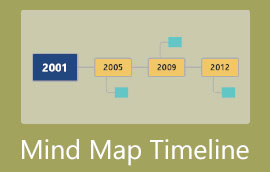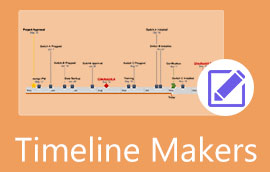Explore the History and 7 Stages of Human Evolution
The story of how humans became who we are today is really interesting. It's like a long journey that started a very long time ago. Just as we slowly changed from a simple species to a complex and diverse people, we are now. It's a story about how we learned to adapt and change and became smart and curious creatures today. Yet, some of us might be wondering about the history of human evolution. If you’re one of them, you are surely lucky! In this post, we have discussed human evolution and its timeline. Not only that, we will also share the perfect tool you can use to make your human evolution timeline.

- Part 1. Introduction to Human Evolution
- Part 2. Human Evolution Timeline
- Part 3. 7 Stages of Human Evolution
- Part 4. FAQs About Human Evolution Timeline
Part 1. Introduction to Human Evolution
Evolution studies how traits within a group of organisms change across generations. In human evolution, scientists propose that modern humans came from extinct human-like species and primates. These changes span millions of years. The concept of human evolution revolves around the principle of natural selection. It was introduced by the renowned naturalist Charles Darwin. Natural selection refers to how an organism's genetic composition changes over time. This enables it to better adapt to its surroundings. Darwin was a pioneer in the realm of human evolution. A significant insight from his theories is the shared ancestry of all life forms on Earth.
The shift from apes to humans began with the adoption of bipedalism, or walking on two legs. An ancestor of humans, also called Sahelanthropus tchadensis, commenced this transition approximately 6 years ago. Homo sapiens, the species to which all modern humans belong, emerged about 5 million years after this transition. Throughout this long period of human evolution, various human species thrived, evolved, and eventually died.
All in all, human evolution is a complex and ongoing process that spans millions of years. It involves the gradual development of various traits and characteristics in our species.
In the following part, let’s dig deeper into the timeline of human evolution from 55 million years ago.
Part 2. Human Evolution Timeline
So, you already learned what human evolution is; let’s dig deeper into its timeline. Human evolution happened a long, long time ago, 55 million years ago, to be exact.
55 million years ago
The first primates begin the process of evolution.
5.8 million years ago
The concept of walking on two legs emerges as the oldest recorded human ancestor. This concept is also called Bipedalism.
2.5 to 2 million years ago
Early Homo emerged in East Africa through speciation from australopithecine predecessors.
230,000 years ago
This is when Neanderthals start showing up. They're found all over Europe, from Britain to Iran. But they became extinct about 28,000 years ago when modern humans became the dominant group.
195,000 years ago
This marks the initial appearance of modern humans, or Homo sapiens, as we call them. These Homo sapiens then travel across Asia and Europe.
50,000 years ago
This is when human culture begins to grow much faster in the timeline of human history.
12,00 years ago
Modern humans have reached the Americas.
5,500 years ago
The Bronze Age began after the Stone Age.
4,000-3,500 years ago
The people called Ancient Sumerians in Mesopotamia created the world's very first civilization.
Check out the sample human evolution timeline below. And learn how to create one as you keep reading.

Get a detailed human evolution timeline.
Are you in search of a tool for creating a timeline, specifically to create one for your human evolution study? Well, we've got you covered! One of the best solutions that can help you make your own timeline is MindOnMap. It is a free online web-based website you can access on any browser like Google Chrome, Safari, Edge, Firefox, and more. Recently, the tool was updated, allowing you to download its app version on your Windows 7/8/10/11 PC.
MindOnMap has a lot of features and functions to offer. It enables you to create your mindmap, org-chart map (up and down), treemap, fishbone, and flowchart. You can also choose your shapes, lines, color fills, and themes and add text to your work. Furthermore, it also provides an option to share or collaborate with your friends or colleagues using a shareable link. Not to mention its capability to secure your creations by setting a password and date validation. All these tool’s elements can also be used on your timeline, too! With MindOnMap's flowchart function, you can easily create your human evolution timeline chart. Find out how this free tool works for your timeline by following the guide below.
Access the Web-based Tool or Download It
To begin with, launch your preferred web browser and navigate to the official MindOnMap site. Once there, you may click the Free Download or Create Online button. To fully access the tool, register for an account. After the registration, you will be directed to the program's main interface.
Pick a Layout
On the main interface, different layouts and themes are visible. For this guide, we opt for a Flow Chart layout, ideal for creating a human evolution timeline.

Personalize the Timeline
At the left part of your current window, you will see the available shapes you can use for your timeline. You can add lines, desired shapes, texts, color fills, etc., to exhibit the important details of your timeline.

Share the Timeline
Sharing your created timeline with peers or colleagues is possible. Click the Share button located in the upper-right corner. In the dialog box, mark checkboxes for options like Password and Valid until to enhance security and specify a validation date.

Export the Timeline
When you achieve everything you need and want for your timeline, it’s time to export your work. To do it, click the Export button and choose your desired file format for saving. Alternatively, you can exit the program and later resume your progress exactly where you left off. No changes will occur once you reopen the timeline.

Part 3. 7 Stages of Human Evolution
By now, you have learned all about human evolution and its timeline. Let’s now move on to the 7 stages of human evolution. Below are the key stages and their explanation.
1. Dryopithecus
Dryopithecus are regarded as the ancestors of both humans and apes. Genus Dryopithecus are also referred to as the oak wood apes. They lived in China, Africa, Europe, and India. During the time of Dryopithecus, its tropical habitat was abundant with dense forests. As a result, its population likely consisted mainly of herbivores.
2. Ramapithecus
Ramapithecus was initially found in the Shivalik range in Punjab and later in Africa and Saudi Arabia. They inhabited open grasslands. Two key pieces of evidence support their Hominid status:
◆ Thicker tooth enamel, robust jaws, and shorter canines.
◆ Use of hands for food and defense, along with inferred upright posture.
3. Australopithecus
This genus was first discovered in 1924 in South Africa. Australopithecus lived on the ground, utilized stones as weapons, and walked upright. They left their mark with a height of around 4 feet and weighed 60-80 pounds.
4. Homo Erectus
The initial Homo Erectus fossil was found in Java in 1891 and referred to as Pithecanthropus Erectus. This species was seen as a missing link between humans and apes. Another significant find in China was the Peking Man, showcasing larger cranial capacities and communal living. Homo erectus crafted tools from quartz, bone, and wood, providing evidence of collective hunting and fire usage. They are thought to have lived in caves.
5. Homo Sapiens Neanderthalensis
Homo Erectus eventually evolved into Homo Sapiens. During this evolution, two subspecies emerged. One of these species was the Homo sapiens neanderthal. Neanderthals exhibited a cranial capacity increase from 1200 to 1600 cc and crafted small hand axes. They were capable of hunting mammoths and other large game.
6. Homo Sapiens Sapiens
The other subspecies of Homo sapiens was Homo sapiens sapiens.
7. Homo Sapiens
Homo Sapiens is the species of all human beings that live today. The remains of Homo Sapiens were first found in Europe and named Cro-Magnon. They displayed reduced jaws, a modern human’s chin appearance, and a rounded skull. Modern humans also evolved in Africa and spread worldwide 200,000 years ago.
Further Reading
Part 4. FAQs About Human Evolution Timeline
What did humans evolve from in order?
Early humans changed from Homo habilis to Homo erectus and finally to Homo sapiens. Along the way, they created basic tools for survival.
When did humans first appear on Earth?
Homo habilis, also called the “handyman,” is among the earliest known humans identified. They inhabited Eastern and Southern Africa approximately 1.4 to 2.4 million years ago.
How old is the human race?
The age of the human race refers to the time since the emergence of anatomically modern humans, Homo sapiens. As mentioned earlier, this is estimated to be around 300,000 to 200,000 years ago. Therefore, the human race is approximately 200,000 to 300,000 years old based on human evolution.
Conclusion
To end, you now know the human evolution timeline through this article. It will be easier for you to understand the evolution of man with the use of a timeline. Indeed, it is the best way to connect us from the past, present, and future. Yet, there are numerous tools that can help you create a timeline. But if you’re looking for reliable and easy-to-use software, MindOnMap is the best one! What’s more interesting is that its web-based version is free, so you don’t need to spend a penny to enjoy its full features and functionalities.










